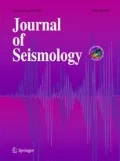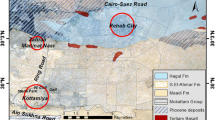Abstract
Prague is the capital of the Czech Republic with 1.3 million inhabitants. It is situated in an intraplate region with low seismicity. The seismic hazard is low, but not negligible. In its evaluation, we face the following challenging issues: (1) there have been no M > 6 events during the period covered by historical catalog (Giardini et al. 2013) although there is evidence from paleoseismic research of earthquakes with magnitude of at least 6.5. It is difficult to determine a reliable magnitude frequency distribution from sparse data. (2) There are no GMPEs determined from strong ground motion data for the region of interest. Therefore, we studied the attenuation from recent weak earthquakes in order to determine which of the published GMPEs are suitable for the region. (3) There are plenty of faults in the city and its neighborhood, all of them believed to be seismically inactive. We have to quantify the probability of an unexpected earthquake on such faults. We used the concept of diffused seismicity for this purpose. (4) The hazard is dominated by the 140 km distant West Bohemia Source Zone with earthquake swarm activity, which does not follow the classical mainshock-aftershock model. The results in the present study were obtained through the OpenQuake engine, the open-source software for seismic risk and hazard assessment developed within the global earthquake model (GEM) initiative. The seismic hazard for Prague (expressed in terms of peak ground acceleration) is below 0.1 g for the returning period of 10,000 years.







Similar content being viewed by others
References
Atkinson GM, Boore DM (2006) Earthquake ground-motion prediction equations for eastern North America. Bull Seismol Soc Am 96(6):2181–2205
Campbell KW (2003) Prediction of strong ground motion using the hybrid empirical method and its use in the development of ground motion (attenuation) relations in eastern North America. Bull Seismol Soc Am 93(3):1012–1033
Cauzzi C, Faccioli E (2008) Broadband (0.05 to 20s) prediction of displacement response spectra based on worldwide digital records. J Seismol 12:453–475
Gallovič F, Brokešová J (2008) Probabilistic aftershock hazard assessment II: application of strong ground motion simulations. J Seismol 12:65–78. https://doi.org/10.1007/s10950-007-9070-2
Giardini D et al (2013) Seismic Hazard harmonization in Europe (SHARE): online data resource, p 2013. https://doi.org/10.12686/SED-00000001-SHARE
Goulet CA, Bozorgnia Y, Abrahamson NA (2015) NGA-east: median ground-motion models for the central and eastern North America region, PEER report no. 2015/04, chapter 1, Pacific Earthquake Engineering Research Center Headquarters at the University of California, Berkeley
Hakimhashemi AH, Grünthal G (2012) A statistical method for estimating catalog completeness applicable to long-term nonstationary seismicity data. Bull Seismol Soc Am 102(6):2530–2546
Leonard M (2010) Earthquake fault scaling: self-consistent relating of rupture length, width, average displacement, and moment release. Bull Seismol Soc Am 100:1971–1988
Málek J, Buben J (1996) Probabilistic eartquake hazard assessment for locality Praha. Acta Montana 102:67–83
Pagani M, Monelli D, Weatherill G, Danciu L, Crowley H, Silva V et al (2014) OpenQuake engine: an open hazard (and risk) software for the global earthquake model. Seismol Res Lett 85(3):692–702
Pezeshk S, Zandieh A, Tavakoli B (2011) Hybrid empirical ground-motion prediction equations for eastern North America using NGA models and updated seismological parameters. Bull Seismol Soc Am 101(4):1859–1870
Scholz CH (2002) The mechanics of earthquakes and faulting, 2nd edn. Cambridge University Press, Cambridge First published 1990, ISBN-13: 978–0521655408
Somerville P, Graves R, Collins N, Song SG, Ni S, Cummins P (2009) Source and ground motion models for Australian earthquakes, Report to Geoscience Australia. Available at: http://www.ga.gov.au/cedda/publications/193?yp=2009
Štěpančíková P, Fischer T, Stemberk J, Nováková L, Hartvich F, Figueiredo PM (2019) Active tectonics in the Cheb basin: youngest documented Holocene surface faulting in Central Europe? Geomorphology 327:472–488
Toro GR (2002) Modification of the Toro et al.(1997) attenuation equations for large magnitudes and short distances. Risk Engineering Technical Report
Woessner J, Danciu L, Giardini D, the SHARE consortium (2015) The 2013 European seismic Hazard model: key components and results. Bull Earthq Eng 13:3553–3596. https://doi.org/10.1007/s10518-015-9795-1
Acknowledgments
This work was supported by ČEZ a.s. company in the scope of international project Sigma2 and by the long-term conceptual development of Institute of Rock Structure and Mechanics CAS, RVO: 67985891.
Author information
Authors and Affiliations
Corresponding author
Additional information
Publisher’s note
Springer Nature remains neutral with regard to jurisdictional claims in published maps and institutional affiliations.
Rights and permissions
About this article
Cite this article
Málek, J., Vackář, J. Site-specific probabilistic seismic hazard of Prague (Czech Republic). J Seismol 23, 1223–1232 (2019). https://doi.org/10.1007/s10950-019-09859-6
Received:
Accepted:
Published:
Issue Date:
DOI: https://doi.org/10.1007/s10950-019-09859-6




